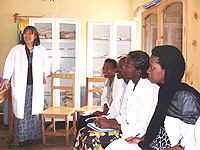There is a critical need to transform health care from a sick care system to a system that optimizes well-being and stresses disease prevention and health promotion. This is especially true when we consider that improvements in reducing infant mortality have stalled as preterm and low birth weight births have increased.


There is a critical need to transform health care from a sick care system to a system that optimizes well-being and stresses disease prevention and health promotion.
This is especially true when we consider that improvements in reducing infant mortality have stalled as preterm and low birth weight births have increased.
The Minister of Health, Hon. Dr. Richard Sezibera, last month, revealed that Rwanda’s impressive strides in curbing maternal and child deaths have put the country in the lead within the region.
This was during the opening of a three-day conference aimed at tackling problems and challenges that lead to maternal and child deaths.
Women and children play an important role in the country’s development and this is why there is need to elevate the profile of maternal and child health to a more prominent position in the development and health strategies.
Based on research from the Ministry of Health, the maternal mortality rate has reduced by 30 percent since 2005 and government aims at reducing it further to 50 percent and childhood deaths by two-thirds by 2015.
Annual statistics carried out by the Ministry of Health show that about 2,767 women still die during pregnancy or immediately after delivery and 13,000 children die before their first birthday.
Like in many developing countries, poverty is the main cause of these deaths. There is an increased need to provide equipment to health centres and training of health workers.
State programs are keenly aware that maternal mortality rates have to be reduced to the minimum as indicated in Millennium Development Goals.
Expanding health insurance coverage will help substantially, but we will not completely reduce disparities or improve health outcomes unless there is a sustained effort to improve public health systems and services addressing the root causes of disease and poor health care.
The Government of Rwanda has worked hard in the past years to provide quality affordable health insurance coverage through Mutuelle de Sante and RAMA. C
omprehensive insurance benefits package should include evidence based services required for all women of reproductive age, children, adolescents, children with special health care needs, and their families.
Because health insurance coverage alone is essential but not sufficient to improve the overall health of populations, adequate support for state and community wide public health systems and preventive services must be included in any health reform package.
There should be explicit recognition that women and children have needs that require specific expertise and a central point of public accountability to ensure ongoing attention and leadership.
As Rwanda develop plans to reform the health care system, state maternal and child health programs should be significantly strengthened to expand and ensure statewide implementation of enabling services that help people effectively access care, also population based services that promote prevention for all residents, and infrastructure building services that ensure a system is in place to meet the health needs of all.
Population based services consist of primary prevention strategies for maternal and child health populations such as public information, education, and policy development to prevent injuries, lead poisoning, and chronic dis¬ease, promotion of oral health, coordination of statewide immunization activities, interventions to reduce preterm birth, infant mortality and sudden infant death syndrome as well as programs to improve nutrition and prevent tobacco, alcohol and use of other drugs especially during pregnancy, and prevention of activities that increase the risk of HIV transmission and sexually transmitted diseases.
State maternal and child health programs should also be strengthened to continue to guide the implementation of systems of comprehensive secondary prevention services including newborn screening and counseling; promotion of regionalized systems of perinatal and neo¬natal high risk services, high risk tracking and follow-up services, early intervention services and infectious disease control.
Additionally, evidence indicates that even insured individuals might not receive recommended preventive services. Therefore is need for efforts to ensure that any insurance benefit package includes coverage of all recommended clinical preventive services with minimal or no cost sharing requirements that pose barriers to utilization.
Today, our leaders work to prevent the burden of chronic disease and injury throughout the lifespan by developing, coordinating, monitoring and evaluating disease prevention and health promotion services for all women and children.
I think all state health departments are required to conduct comprehensive needs and assessments that can be done in a specified period of time to determine the top preventive priority health issues facing women and children.
Health care reform offers a prime opportunity to shift from a sick care system to a true health system by investing in the infrastructure and programs that combat chronic illness, injury and disease.
By expanding these systems to meet current needs and utilizing the proven programs and strategies that address preventable illness, we can save even more women and children’s lives while providing cost savings to the nation during economically troubling times.
Ends


